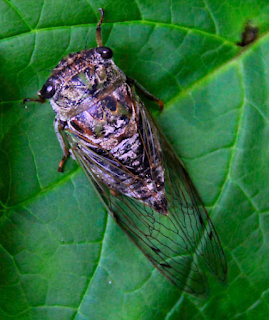I hear singing
Yesterday was a very special day. I was walking in front of the house headed out to do errands about 10 am when I heard a rustling in the grass. It repeated itself but when I looked down I couldn't see anything. Then I heard it again. It sounded like a large fly. Finally, I saw a big object flapping its wings really fast. The wings were a big blur. It was an Iowa locust that appeared to be caught under the netting the Google folks laid down after running the new fiberoptic down along the street.
I was going to go back to my room to get my jar but instead grabbed an envelope from my backpack and scraped the locust into that. Then I went up to my room, poured the locust into my jar and took a picture of it. After I took a picture of it I shook the jar and it looked dead as a door nail. I felt horrible. I guess I had been a little rough with it when I scooped it into the envelope. Or maybe the jar had some Clorox bleach remaining in it from the last time I cleaned it. I'm afraid I killed some goldfish that way many years ago when I decided to be fastidious and clean the goldfish bowl with bleach. They sure didn't like that. They swam around in circles like crazy and then died a few hours later. Then I took the dead locust out the back door and poured him out by the tree root in the back yard. He started crawling! I guess he had been playing dead. I was so happy. He was not only alive but also taught me a useful lesson.
The cicadas I have to say are not attractive creatures. In fact if you happen to spy one of their hollow shells on a tree, you jump out of your skin when you're a kid. It truly looks like a monster and would be great in a horror picture show all blown up. Then you (as a kid) realize it's not a creature but just a shell that was shed by the actual animal.
(use this picture until I figure out how to get the picture I took off my phone)
I really shouldn't insult this insect. Whose to say what is UGLY. Insects are so different from us that we think all of them are ugly. I'm sure they think the same of us (if they can see us as an object and not a huge wall coming toward them). I think it would benefit it us all if we spent more time with insects, animals, nonhuman living things aka Nature, so that if and when we encounter other "creatures" say from outer space, we will have less of a culture shock.
Up until I read this article I had no idea that those poor creatures live two feet underground as babies for 17 years, clinging to a tree root and sucking on its sap. After SEVENTEEN YEARS, they emerge, climb up a tree and shed their ugly skin. Then for six weeks they mate and then die! What a life. Do I have a right to complain? Living over 60 years and all of them above ground, free to move about? Look at those big eyes. What are they looking at for 17 years?
During the next six weeks the eggs that were laid by the females hatch and the new generation of "nymphs" burrow underground and attach themselves to a tree root like the former generation did. Let's hang out for another seventeen years and then we get to mate and then we get to die!
Here is some more information from my Go TO Experts here in Iowa--the ISU Extension Service. We learned in library school what a great resource for information they are for all things Nature.
---
The periodical cicadas have spent the past 17 years as nymphs located 18 to 24 inches deep in the soil of wooded and forested areas, feeding on sap from tree roots. The nymphs dig their way out of the soil during late May and June and climb up tree trunks, posts and poles. The outer shell of the nymph splits along the middle of the back, and the winged adult laboriously emerges in about an hour.
Each adult may live for 5 or 6 weeks. During that time the males and females mate and the females lay the eggs that are the start of the next generation. Eggs are laid into the small twigs of trees and shrubs.
The eggs hatch after 6 to 7 weeks and the newly hatched nymphs fall to the ground, burrow until they find a suitable tree root, and begin the feeding and waiting for several years (17).
Periodical cicadas are well-known for the incredible noise they make when they emerge. The males "sing" with a loud buzzing or drumming sound that goes on all day long. With populations that can reach up to a million and a half cicadas per acre, the sound can be as deafening as it is incessant.
The cicada males sing by vibrating two shell-like drums located along the sides of the abdomen. Strong muscles vibrate the drum membranes several times per second. The resulting high-pitched, rapid clicks are resonated through air sacs and other structures to control sound volume and quality. The upward angles of the wings form a megaphone-like chamber that further controls the sound.




Comments
Post a Comment